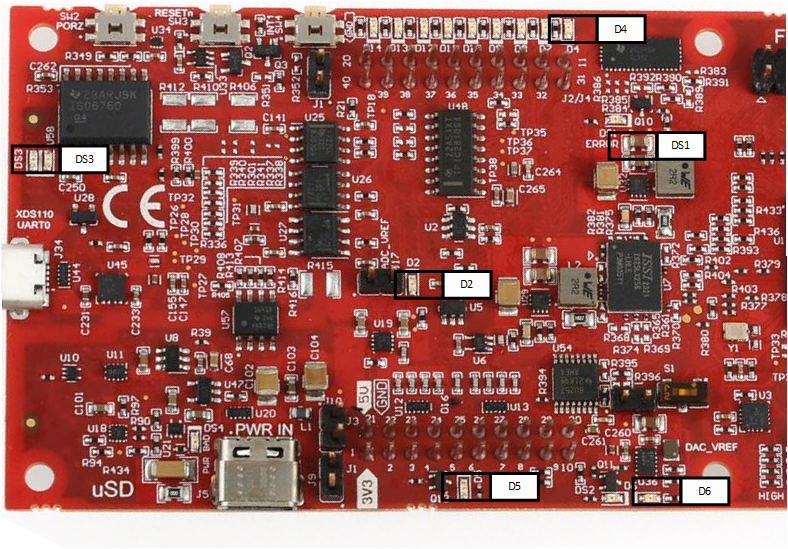SPRUJF1 November 2024 AM2612
ADVANCE INFORMATION
- 1
- Description
- Key Features
- 1LaunchPad Module Overview
-
2Hardware Description
- 3.1 Board Setup
- 3.2 Functional Block Diagram
- 3.3 GPIO Mapping
- 3.4 Reset
- 3.5 Clock
- 3.6 Memory Interfaces
- 3.7 Ethernet Interface
- 3.8 I2C
- 3.9 Industrial Application LEDs
- 3.10 SPI
- 3.11 UART
- 3.12 MCAN
- 3.13 FSI
- 3.14 JTAG
- 3.15 TIVA and Test Automation Pin Mapping
- 3.16 LIN
- 3.17 ADC and DAC
- 3.18 EQEP and SDFM
- 3.19 EPWM
- 3.20 USB
- 3.21 BoosterPack Headers
- 3Known Issues and modifications done on LP-AM261 RevE1
- 4Additional Information
- 5References
- 6Revision History
2.1.1.2 Power Status LEDs
Multiple power-indication LEDs are provided onboard to indicate to users the output status of major supplies. The LEDs indicate power across various domains.
Table 2-3 Power Status LEDs
| Name | Default Status | Operation | Function |
|---|---|---|---|
| D7 | ON | VSYS_5V0 | Power indicator for supply 5V voltage |
| D14 | ON | VSYS_3V3 | Power indicator for generated 3.3V voltage |
| D16 | ON | VSYS_2V5 | Power indicator for generated 2.5V voltage |
| D12 | ON | VDD_1V2 | Power indicator for generated 1.2V power-good voltage |
| D15 | ON | VSYS_1V8 | Power indicator for generated 1.8V voltage |
| D13 | OFF | WARMRSTN | Power indication for WARMRSTN |
| DS2 | OFF | SAFETY_ERROR | Power error indication for SAFETY_ERROR |
| D1 | OFF | XDS_PROGSTAZ1 | LED will glow after micro-B connection is made |
| DS1 | OFF | XDS_PROGSTAZ2 | LED will glow to indicate communication over JTAG |
Note: DS2 LED that correspond to SAFETY_ERROR is
always ON.
 Figure 2-3 Power Status LEDs
Figure 2-3 Power Status LEDs